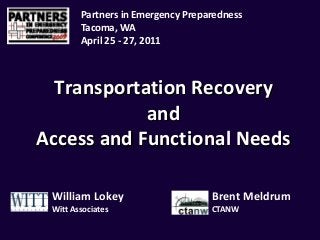Transportation Recovery Planning & People with Special Needs
Speakers: William Lokey, Program Director, Witt Associates Brent Meldrum, CEO, Coastal Transport of Washington ; In our development of the Transportation Recovery Annex as part of the Regional Catastrophic Preparedness Grant Project, we worked with providers of transportation to vulnerable populations. We worked with the Community Transit Association of the Northwest (CTA-NW) which has been actively working on their goal of integrating with the emergency management network in the state. This presentation will help further that goal by: 1. Providing an overview of our Transportation Recovery Planning in the Puget Sound Area and what this planning means to the rest of the state; 2. Providing an overview of the issues, lessons learned and best practices concerning emergency transportation for vulnerable populations and persons with special needs; 3. Introducing CTA-NW, its mission, resources, contacts and capabilities; 4. Discussing planning considerations for special needs populations in evacuation and transportation recovery; 5. Providing the opportunity to build partnerships among PIEP Conference attendees and the CTA-NW.

Recommended
Recommended
More Related Content
More from Partners in Emergency Preparedness Conference
More from Partners in Emergency Preparedness Conference (20)
Transportation Recovery Planning & People with Special Needs
- 2. Objectives • Introduce Transportation Recovery Annex • Define access and functional needs • Legal Issues • Explore lessons learned and best practices • Introduce CTANW • Present their capabilities and resources • Discuss developing partnerships
- 3. Regional Transportation Recovery Annex Puget Sound Regional Catastrophic Preparedness Grant Program
- 5. • Management Information • Alternative Routes • Level of Service (LOS) • Strategies • Resources Deliverables:
- 6. In General • CPG 101 Format • Description of multi modal system • Roles and responsibilities • Info drawn from existing plans • Tools, information and options • Recommendations
- 19. Regional Coordination – Appendix C Locally Developed – Bottom Up Existing Organizations State Plan (Draft)
- 25. Define Access and Functional Needs • Visually impaired • Hearing impaired • Mobility impaired • Single working parent • Non‐English speaking persons • People without vehicles • People with special dietary needs • People with medical conditions • People with intellectual disabilities • People with dementia
- 27. Rehabilitation Act of 1973, as amended Section 504 ‐ Programs, Services, and Activities (if Federal financial $ is received) Americans with Disabilities Act of 1990 Title I ‐ Employment Title II ‐ State and Local Government (public Transportation) Title III ‐ Public Accommodations, Commercial Facilities, Private Transportation Providers, and Private Testing Entities Title IV ‐ Telecommunications Architectural Barriers Act of 1968 ‐ (if using Federal $) Fair Housing Act of 1968, as amended Individuals with Disabilities Education Act of 1975, as amended Communications Act of 1934, as amended
- 28. Transportation/Evacuation Issues • Inadequate coordination • Focus on the needs of the majority • Excessive reliance on automobiles • Minimal use of multi modal options • Basic human nature
- 29. Emergency Plans should include: • Communications and support networks • Procedures to deploy transportation resources • Plans to prioritize evacuations • Information distributed on a regular basis • Information targeted to vulnerable populations • Coordination of fuel, repair and support services • Priority for buses high occupancy vehicles • Linkages to the Private Sector
- 30. Access and Functional Needs Transportation Issues • Resources • Registries • Planning • Partnerships
- 37. WIN 211 Call Center Service Areas Washington State 2-1-1 Call Center Service Areas Col- umbia Whitman Clallam Region 6 King County Snohomish Skagit Region 5 South Sound Clark Cowlitz Lewis Grays Harbor Wahkiakum Klickitat Yakima Benton Franklin Walla Walla Gar- field Asotin Adams Region 8 Eastern Washington Lincoln Pend Oreille Stevens GrantKittitas Chelan San Juan Whatcom Ferry Island Skamania Douglas Mason Thurston Okanogan Jefferson Kitsap Pacific Region 7 Region 1 North Sound Region 2 Peninsulas Southwest Region 4 Greater Columbia Call Center, Outreach & Database Management Region Spokane 7/1/10
- 40. Washington State Agencies DSHS – Medicaid Services and Transportation WSDOT ‐ State Transportation Coordination ACCT Council (WSDOT) ACCT Mission: • Promote the coordination of “Access and Functional Needs” transportation • Provide a forum for discussing issues and initiating change • Provide oversight and direction to the state’s coordination agenda • Report to the legislature and propose legislative remedies CTANW Membership
